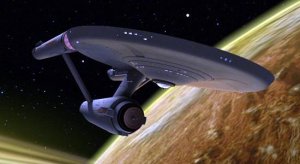 The name Enterprise comes from a long series of ships. The first was the French frigate L'Entreprise, captured by the British in 1705. The British rechristened the ship HMS Enterprise for use by the Royal Navy. A further nine Royal Navy commissioned warships carried the name "Enterprise". The first United States ship to use the name USS Enterprise was a Revolutionary War-era sloop-of-war. The eighth American ship to bear this name was the world's first nuclear aircraft carrier.
The name Enterprise comes from a long series of ships. The first was the French frigate L'Entreprise, captured by the British in 1705. The British rechristened the ship HMS Enterprise for use by the Royal Navy. A further nine Royal Navy commissioned warships carried the name "Enterprise". The first United States ship to use the name USS Enterprise was a Revolutionary War-era sloop-of-war. The eighth American ship to bear this name was the world's first nuclear aircraft carrier.According to The Star Trek Encyclopedia, the registry number "NCC-1701" was devised by Matt Jefferies, art director of the first Star Trek series. Jefferies, who is a pilot, based NCC on 20th century aircraft registration codes. In such 20th century usage, an "N" first letter refers to an aircraft registered in the USA. A "C" for a second letter refers to a civil aircraft. Jefferies added a second "C", just because he thought it looked better."
The Franz Joseph Blueprints and a handful of Star Trek novels state that NCC is an initialism for "Naval Construction Contract".
In Gene Roddenberry's original Star Trek pitch, the starship is described as a "United Space Ship," and in two episodes of the original series (TOS), Kirk refers to the "United Space Ship Enterprise".
Before Star Trek: The Motion Picture, Paramount had planned a new Star Trek television series to have been named Star Trek: Phase II. Early in the production, Ralph McQuarrie had been hired to redesign the ship. The major feature of the redesign was to replace the cigar-shaped secondary hull with a larger, triangle-shaped section. McQuarrie's design was discarded in favor of keeping the general shape of the ship intact.
In the Star Trek universe, there have been a number of starships named Enterprise:
- USS Enterprise (XCV 330) Declaration class (circa 2130s) from art in Star Trek: The Motion Picture, and the series Star Trek: Enterprise.
- Enterprise (NX-01) NX class (2151–2161) from the series Star Trek: Enterprise.
- USS Enterprise (NCC-1701) Constitution class (2245–2285) from the original Star Trek series, the first three films and 2009's Star Trek.
- USS Enterprise (NCC-1701-A) Constitution (also listed as Enterprise) class (2286–2293) from the films The Voyage Home, The Final Frontier and The Undiscovered Country.
- USS Enterprise (NCC-1701-B) Excelsior class (2293–2320s) from the film Generations.
- USS Enterprise (NCC-1701-C) Ambassador class (2332–2344) from the episode "Yesterday's Enterprise".
- USS Enterprise (NCC-1701-D) Galaxy class (2363–2371) from the series Star Trek: The Next Generation and film Generations.
- USS Enterprise (NCC-1701-E) Sovereign class (2372—) from the films First Contact, Insurrection, and Nemesis
- USS Enterprise (NCC-1701-J) (26th century) from the episode "Azati Prime"
From licensed Star Trek fiction and notable unlicensed films:
- USS Enterprise (NCC-1701-F) (late 24th century) from the novel Imzadi and the Millennium trilogy of Star Trek novels
- USS Enterprise (NCC-1701-M) Constitution class (2306—) a museum ship from the Tim Russ production Star Trek: Of Gods and Men
 Ralph McQuarrie's Redesigned Enterprise
Ralph McQuarrie's Redesigned Enterprise Final Phase II Design
Final Phase II Design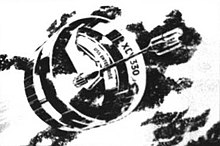 This USS Enterprise (XCV 330) appears in Star Trek: The Motion Picture among a series of illustrations depicting ships named Enterprise. The 1979 Star Trek Spaceflight Chronology describes this "first interstellar liner" as a Declaration-class ship launched in 2123
This USS Enterprise (XCV 330) appears in Star Trek: The Motion Picture among a series of illustrations depicting ships named Enterprise. The 1979 Star Trek Spaceflight Chronology describes this "first interstellar liner" as a Declaration-class ship launched in 2123 The United Earth Starfleet's Enterprise is the main setting of Star Trek: Enterprise.
The United Earth Starfleet's Enterprise is the main setting of Star Trek: Enterprise.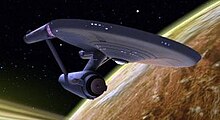
The Federation's first Enterprise is the main setting of the original Star Trek series (1966–1969) and The Animated Series (1973–74). A refitted Enterprise appears in Star Trek: The Motion Picture (1979) and Star Trek II: The Wrath of Khan (1982), before being destroyed in Star Trek III: The Search for Spock (1984)
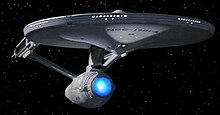 This ship first appears at the end of Star Trek IV: The Voyage Home (1986) and is the main setting of Star Trek V: The Final Frontier (1988) and Star Trek VI: The Undiscovered Country (1991). The ship is ordered decommissioned at the end of The Undiscovered Country. Paperwork included with the model kit indicated the ship was mothballed at the Memory Alpha ship museum, and William Shatner's novel The Ashes of Eden (1996) depicts the Enterprise-A's removal from the mothball fleet before being destroyed defending the planet Chal.
This ship first appears at the end of Star Trek IV: The Voyage Home (1986) and is the main setting of Star Trek V: The Final Frontier (1988) and Star Trek VI: The Undiscovered Country (1991). The ship is ordered decommissioned at the end of The Undiscovered Country. Paperwork included with the model kit indicated the ship was mothballed at the Memory Alpha ship museum, and William Shatner's novel The Ashes of Eden (1996) depicts the Enterprise-A's removal from the mothball fleet before being destroyed defending the planet Chal. Launched at the start of Star Trek Generations (1994). James T. Kirk goes missing during the ship's maiden voyage. According to Star Trek novels, Demora Sulu becomes captain after Harriman.
Launched at the start of Star Trek Generations (1994). James T. Kirk goes missing during the ship's maiden voyage. According to Star Trek novels, Demora Sulu becomes captain after Harriman.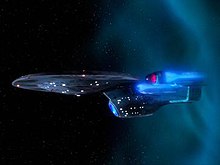 This ship appears in the Next Generation episode "Yesterday's Enterprise" (1990). The ship was destroyed attempting to defend the Klingon outpost Narendra III from Romulan attack. Survivors included Tasha Yar (Denise Crosby), whose alternate timeline version from "Yesterday's Enterprise" travels with the ship back in time to the battle over Narendra III. The actions of the Enterprise-C's crew became a catalyst for the alliance between the Federation and the Klingon Empire
This ship appears in the Next Generation episode "Yesterday's Enterprise" (1990). The ship was destroyed attempting to defend the Klingon outpost Narendra III from Romulan attack. Survivors included Tasha Yar (Denise Crosby), whose alternate timeline version from "Yesterday's Enterprise" travels with the ship back in time to the battle over Narendra III. The actions of the Enterprise-C's crew became a catalyst for the alliance between the Federation and the Klingon Empire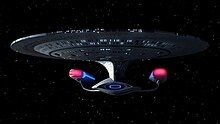 The main setting of Star Trek: The Next Generation (1987–1994). The Enterprise was lost in 2371 after an attack by a renegade Klingon Bird-of-Prey (commanded by the Duras sisters) caused extensive damage, leading to a warp core breach. Although the saucer section was safely separated before the breach, the shock wave from the explosion forced it into the atmosphere of Veridian III. The ship, however, was not salvageable.
The main setting of Star Trek: The Next Generation (1987–1994). The Enterprise was lost in 2371 after an attack by a renegade Klingon Bird-of-Prey (commanded by the Duras sisters) caused extensive damage, leading to a warp core breach. Although the saucer section was safely separated before the breach, the shock wave from the explosion forced it into the atmosphere of Veridian III. The ship, however, was not salvageable. The main setting for the films Star Trek: First Contact (1996), Star Trek: Insurrection (1998), and Star Trek Nemesis (2002).
The main setting for the films Star Trek: First Contact (1996), Star Trek: Insurrection (1998), and Star Trek Nemesis (2002). The Star Trek: Enterprise episode "In a Mirror, Darkly" features a Mirror Universe version of the NX-01 Enterprise. This ship is equipped with a cloaking device, deflector shields, a tractor beam, a prototype Agony Booth, and different exterior markings. It is commanded by Captain Maximilian Forrest, although for a brief time his first officer, Commander Jonathan Archer, takes command following a mutiny. This Enterprise is destroyed by the Tholians.
The Star Trek: Enterprise episode "In a Mirror, Darkly" features a Mirror Universe version of the NX-01 Enterprise. This ship is equipped with a cloaking device, deflector shields, a tractor beam, a prototype Agony Booth, and different exterior markings. It is commanded by Captain Maximilian Forrest, although for a brief time his first officer, Commander Jonathan Archer, takes command following a mutiny. This Enterprise is destroyed by the Tholians. A Mirror Universe Enterprise appears in the original Star Trek episode "Mirror, Mirror". The ship is equipped with an agony booth and the mirror Captain Kirk's deadly Tantalus device. The ISS Enterprise was originally the same shooting model as the regular Enterprise. The remastered version of "Mirror, Mirror" includes a CGI version of Enterprise with "ISS" markings on the hull and minor physical differences from USS Enterprise, such as a larger deflector dish, a taller bridge, and altered nacelle details
A Mirror Universe Enterprise appears in the original Star Trek episode "Mirror, Mirror". The ship is equipped with an agony booth and the mirror Captain Kirk's deadly Tantalus device. The ISS Enterprise was originally the same shooting model as the regular Enterprise. The remastered version of "Mirror, Mirror" includes a CGI version of Enterprise with "ISS" markings on the hull and minor physical differences from USS Enterprise, such as a larger deflector dish, a taller bridge, and altered nacelle details Measurements for this version's final size range from 610 meters to 910 meters. In an interview in Cinefex magazine #118, Industrial Light & Magic Art Director Alex Jaeger discussed the design's growth in size during early production of the film, saying "The reconfigured ship was a larger vessel than previous manifestations – approximately 1,200 feet (370 m) long compared to the 947 foot (289 m) ship of the original series. Once we got the ship built and started putting it in environments it felt too small. The shuttle bay gave us a clear relative scale – shuttles initially appeared much bigger than we had imagined – so we bumped up the Enterprise scale, which gave her a grander feel and allowed us to include more detail." A special feature on starships in the Blu-ray Disc (BD) version of the movie gives the length as 2,379 feet (725 m).
Measurements for this version's final size range from 610 meters to 910 meters. In an interview in Cinefex magazine #118, Industrial Light & Magic Art Director Alex Jaeger discussed the design's growth in size during early production of the film, saying "The reconfigured ship was a larger vessel than previous manifestations – approximately 1,200 feet (370 m) long compared to the 947 foot (289 m) ship of the original series. Once we got the ship built and started putting it in environments it felt too small. The shuttle bay gave us a clear relative scale – shuttles initially appeared much bigger than we had imagined – so we bumped up the Enterprise scale, which gave her a grander feel and allowed us to include more detail." A special feature on starships in the Blu-ray Disc (BD) version of the movie gives the length as 2,379 feet (725 m).















































No comments:
Post a Comment